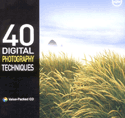
40 Digital Photography Techniques, 3rd Edition
by : Young Jin
O’Reilly Media, Inc.
ISBN: 89-314-3369-7
208 pages
$16.99 US, $22.99 CA
Most people who like taking pictures probably don’t want to spend time reading manuals and long books about camera techniques. Most avid shooters I imagine just want specific techniques and strategies they can easily understand and try out.
Well, Young Jin’s 3rd edition of 40 Digital Photography Techniques is a very useful resources for these type of digital photographers. First off, the almost 7″x7″ size of the book makes it very useful for fitting it into a medium size camera bag and using it when you’re out taking pictures. Secondly, manner of the instructions in the book are easy to follow and apply, though the book does provide some advance techniques.
The contents of the book include:
-Choose, use, and accessorize your digital camera
-Understand and exploit various sources of light
-Get creative with filters
-Become effective with low-light and night photography
-Capture expressive portraits of adults, children, and yourself
-Photograph objects in motion and get great action shots
-Catch the mood of your vacation, a snowy or rainy day, a brilliant
sunrise or sunset
-Shoot everything–panoramas, architecture, landscapes, products,
food, cars, and pets
-Transfer, edit, and print your images, or share them on the Web
Each page contains professional and normal looking photos and captions that illustrate particular techniques. The chapter titles and headings are well designed for easy reference, and each technique is explained in about 3-5 pages.
This book is not only just for 35mm digital camera users. The chapter on Using Flash, for example, provides a really good technique on how and why to diffuse a flash on a point-and-shoot camera, or how to use an equally inexpensive home-made reflector. Many beginning photographers might not understand the importance of using a flash diffuser, but this book explains and illustrates the reason very well.
Even the first section about choosing a digital camera does a good job summarizing exactly what to consider when looking at different types of cameras—from simple point-and-shoots, DSLR’s, to portable cameras with rotating lens or LCD screen. Many of the techniques in this book, however, would be difficult to next impossible to achieve with cameras that fall into the simple automatic point-and-shoot category where you can’t, say, control the aperture and shooter speed.
Other techniques in the book include adjusting for size and quality of photos, shooting close-ups of small objects, taking continuous shots, using white balance, using selective focus, controlling exposure, locking and changing selective focus, and photographing children, pets, weddings, sports events, landscapes, sunrises and sunsets, food and other products. While each of these techniques are covered in other full length books, this book provides a good introduction for beginning photographers. (However, those shooting with a professional a 35mm DSLR camera will probably want something more than what this book offers. There’s no info on how to read a histogram or how to sync and use two external flashes.) The end of each chapter also includes a nice check list of points covered in the chapter. I’ve often found myself making similar checklists for when I’m preparing for photo shoots.
Some advance techniques like light-metering methods, using the Slow Sync mode in flash photography, and various methods for shooting under different lighting conditions are not adequately explained, especially for beginning photographers. Some readers may have to look elsewhere for instructions on these and other advance techniques. A perfunctory illustration of various aperture sizes in a lens, which most digital photography books include, would also have been useful.
Unlike many other digital photographers books, this one doesn’t just provide a few chapters on using a digital camera and then go on to spend two-thirds or more of the book focusing on Photoshop techniques for digital photography. Only the last section, titled “After the Shoot”, spends twelve pages on Photoshop techniques. The entire book indeed covers camera techniques.
40 Digital Photography Techniques would make a great gift for someone who is interested digital photography or if you’re looking to purchase a new digital camera and want to get beyond the typically boring and dictionary style manuals that come with it.
MyMac.com Rating: 4 out of 5

Leave a Reply
You must be logged in to post a comment.